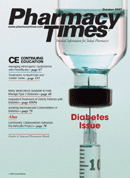Blood Glucose Monitors
Ms. Terrie is a clinical pharmacy writer based in Haymarket, Va.
As technology continues to advance in the development and manufacturing of blood glucose monitors, patients with diabetes benefit from having the ability to select from a variety of self-monitoring devices. These devices enable patients to easily incorporate fast and accurate routine testing into their daily schedules. Examples of new blood glucose monitors introduced to the market this year are Breeze 2 and Contour (Bayer Diabetes Care; March 2007) and FreeStyle Lite (Abbott Diabetes Care; April 2007).
A self-monitoring blood glucose monitor is one of the most valuable tools that patients with diabetes can use for maintaining control of their diabetes. Because a plethora of these devices is available (Table), the selection may be somewhat overwhelming and confusing. Pharmacists can assist patients by informing them about the various brands and types as well as the key features that may enable them to easily integrate routine testing into their daily schedules.
Many factors should be considered when assisting patients in the selection of a monitor that best suits their needs. Examples of these factors include expense, ease of use, an easy-to-follow testing procedure, testing time, accuracy, memory capability, monitor size, portability, blood sample size, battery life, ability for alternate site testing, required maintenance, and cost of necessary accessories. In addition to these factors, some individuals may require monitors with features that accommodate visual or hearing impairments or problems with manual dexterity and arthritis.
In addition to assisting in the selection of an appropriate monitor, pharmacists always should make certain that patients thoroughly understand the correct use of the monitor. They should remind patients to adhere to the directions supplied by the manufacturer with regard to the use and maintenance of the selected monitor. Moreover, pharmacists should educate patients regarding the proper method of self-testing, the importance of testing multiple times a day, and how to interpret the test results. They should direct patients to discuss with a primary health care provider how often and at what times of day to test. Patients also should be encouraged to keep a record of the results and to discuss those results with the primary health care provider.
Pharmacists also can use the counseling opportunity to reinforce the significance of adhering to the treatment plan, including proper diet and prescribed medication. Patients should be reminded to consult their primary health care provider before using any nonprescription medications. Pharmacists should stress the importance of establishing routine care of the teeth and gums, eyes, feet, and skin to reduce or prevent long-term complications associated with uncontrolled diabetes, as well as maintaining routine checkups with their physician.
For more information on the blood glucose meters listed in the Table, visit the manufacturer Web sites for the specific products.

